Haydn and the Cello
The following link opens up a compilation of all the thumbposition passages from Franz Joseph Haydn’s (1732-1809) two concertos (C major and D major) as well as from his Sinfonia Concertante:
HAYDN AND THE FIVE-STRING-CELLO?
Is it possible that Haydn intended some of his soloistic higher register cello compositions (D major Cello Concerto, Sinfonia Concertante etc) to be played on a 5-string instrument in the same way that he possibly wrote the high solo cello parts of his early symphonies for a 5-string cello? Bach and Vivaldi had also previously done the same. The writing in these pieces is so much higher and more virtuosic than his standard cello writing (including that of his C major cello concerto) that we can justifiably wonder if perhaps the cellist for whom Haydn wrote them had an additional high E-string on their instrument. If we play these very difficult pieces on a 5-string instrument, suddenly they become infinitely easier. Now we no longer need to be “Paganinis-of-the-cello” to play them well. Click on the highlighted links below to see all the thumb position passages of these two pieces written out down a fifth. This is how they would be if we played them on a five-string cello.
- D Major Cello Concerto [high passages] (written out down a fifth)
- Sinfonia Concertante [high passages] (written out down a fifth)
Compare for example the difficulty of the cellist’s first melodic solo intervention in the Sinfonia Concertante in the two following versions, for 4-string and 5-string cello. Of course, the 5-string version will sound a fifth higher (i.e. it will sound at the same pitch as the 4-string version) if played on a 5-string cello as though its top string were the “A-string” :

HAYDN’S D MAJOR CONCERTO
This concerto, being standard first round orchestral audition material, is the curse of many aspiring professional cellists’ lives. But most audition first rounds are now played behind a screen, so what is to stop us playing it on a 5-string cello, especially if that is the “authentic” way ? Well, to start with, we would be disqualified for cheating, and secondly the piece would now be so much easier that it wouldn’t be asked for in auditions. But let’s look in more detail at other more realistic consequences of playing it with 5 strings.
While the Sinfonia Concertante seems to lend itself very well to being played on a 5-stringer, the exciting idea that doing the same with the D-major concerto might actually be “authentic” is given a cold shower by the following two passages in the first movement, shown here as they are played on a 4-string cello with the tenths fingered across neighbouring strings, and then (in the lower stave) how they would be played on a 5-string cello with the tenth jumping across two strings:
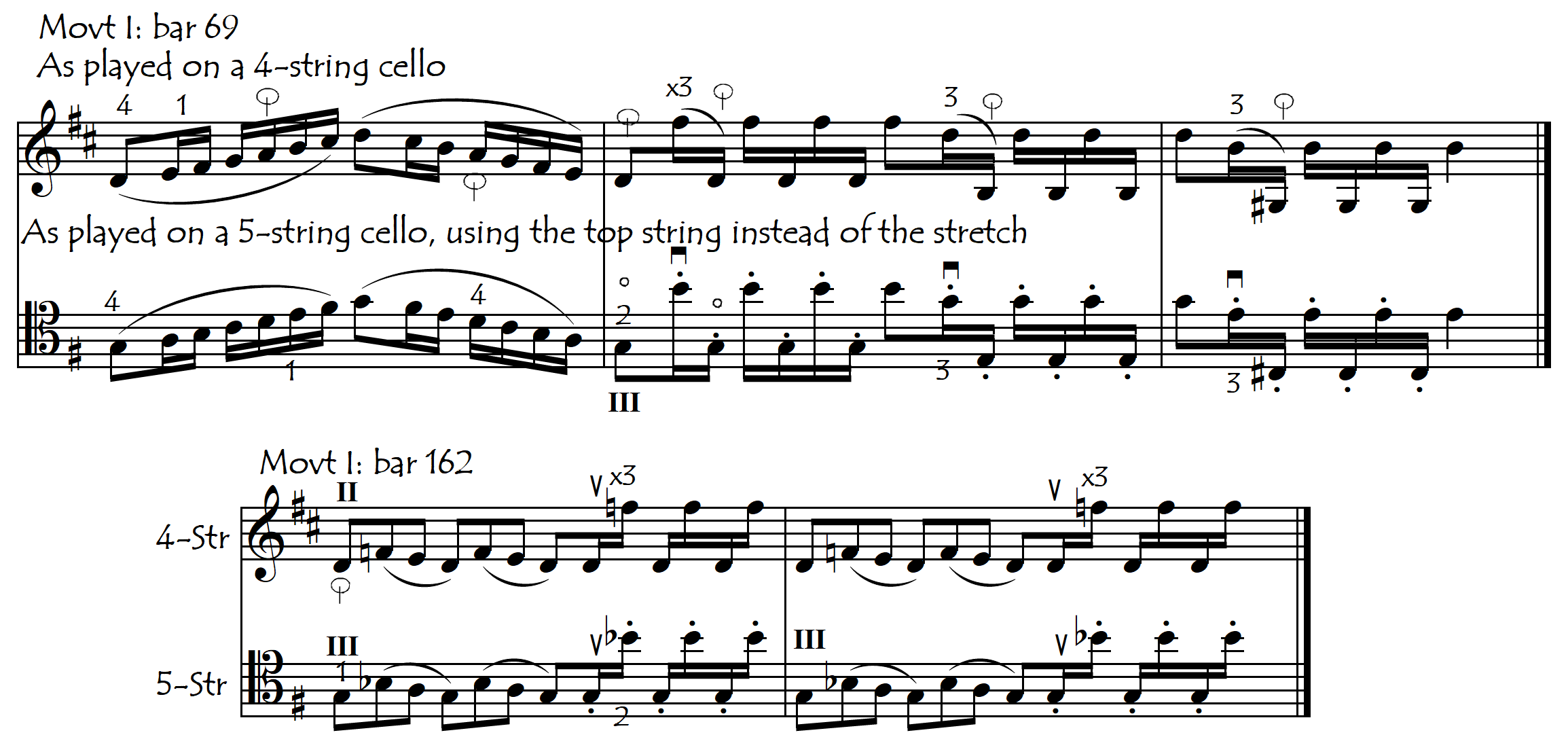
It is hard to imagine these tenths being played by leaping across three strings: this would sound like Prokovieff, Bartok, or maybe Vivaldi, but would definitely not sound like classical “Papa” Haydn. So, assuming therefore that these tenths must be played on neighbouring strings, then the intervals are so physically large in the lower region of the “A” and “E” strings that they would be impossible to play on those two strings. Therefore they would have to be played in the higher reaches of the fingerboard on the “D” and “A” strings. All this means that the extra fifth string would be of no help at all in these passages, and implies (but doesn’t prove) that the cellist for whom it was written was a virtuoso, for whom running up and down the fingerboard between earth and stratosphere was probably not a problem. If Haydn’s cellist could play these two passages, then they could quite probably play the rest of the concerto on a four-string cello also.
Of course it would. however, also be possible to play these two passages high on the A and D strings even on a 5-string cello and still make use of the higher E-string for all the many other passages for which that E-string would make life infinitely easier for us.
OTHER D-MAJOR DOUBTS
Haydn’s D-major concerto is a strange one indeed. Written in 1783, it just seems both too romantic, and too virtuosic to fit in with Haydn’s other compositions. From a cello-technique point of view, this concerto is just so much more virtuosic and high-register than anything that comes before it, especially by Haydn but even by other “cellist-composers” with the exception perhaps of Boccherini (1743-1805). Apart from the very high register, this concerto is in many ways our cellistic equivalent of the Beethoven Violin Concerto, which was written 23 years later. Both are full of scales and arpeggios, treated with a huge variety of rhythmic and melodic permutations.
If the original manuscript had been lost, then we would probably assume this concerto to be a reworking, by a later virtuoso cellist, of a simpler “original” Haydn concerto (or a totally original work not by Haydn at all). But because the autograph manuscript exists, we can only assume that the collaboration with the cellist for whom it was written was so close, that the resulting concerto is ultimately almost a pastiche of the two influences: on the one side a classical Haydn, and on the other side a virtuoso cellist who was far ahead of his time both stylistically and technically (or was playing a 5-string-cello).
Fortunately, the truly wonderful article by Thomas Tolley, “James Cervetto and the Origins Of Haydn’s D Major Cello Concerto” published in Volume 16 of the journal “18th Century Music” in 2019, finally and definitively answers all our questions and clears up all of our doubts: the concerto was written for James Cervetto, an extraordinary virtuoso working in London who was renowned for his mastery of thumbposition and high-register playing. Just look at the following contemporary paintings of him and be aware that the older man who is staring so intently at the thumbposition hand is actually Cervettos father, also a famous cellist, obviously stunned by this new technique (see History Of Thumbposition). Even the painter in the background has his left thumb featured prominently. In both of these paintings, Cervetto seems to be using an extension up to the fourth finger in thumbposition:
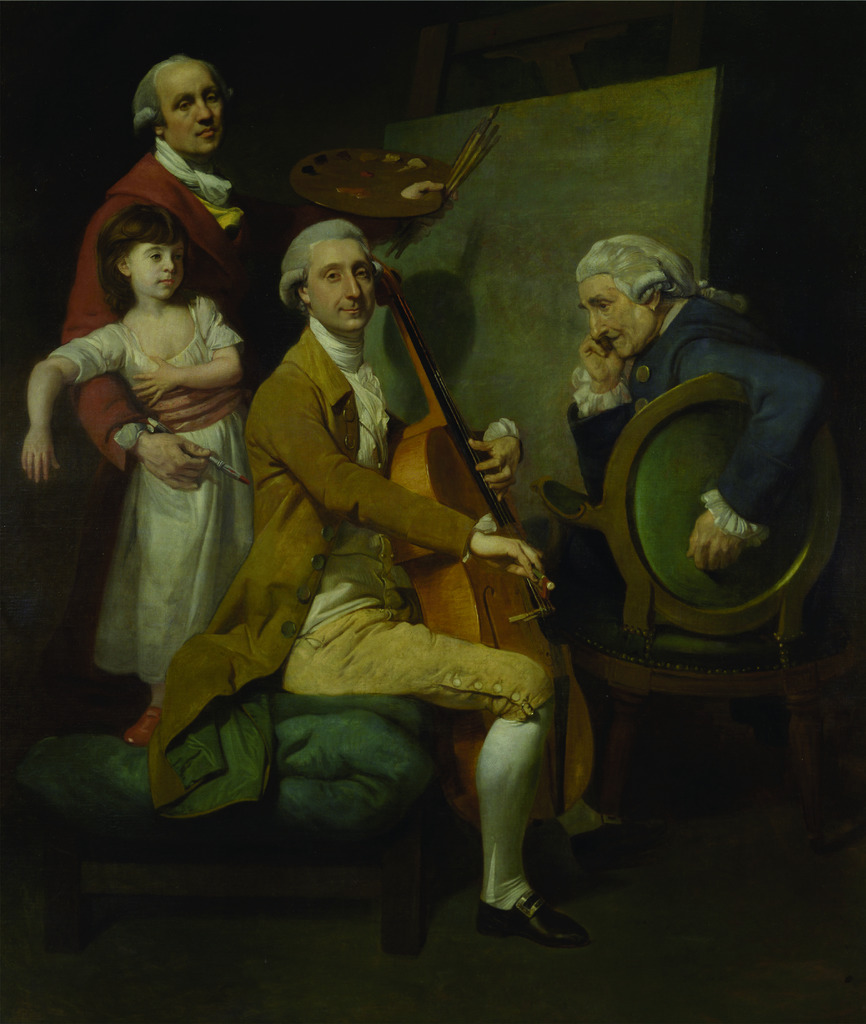
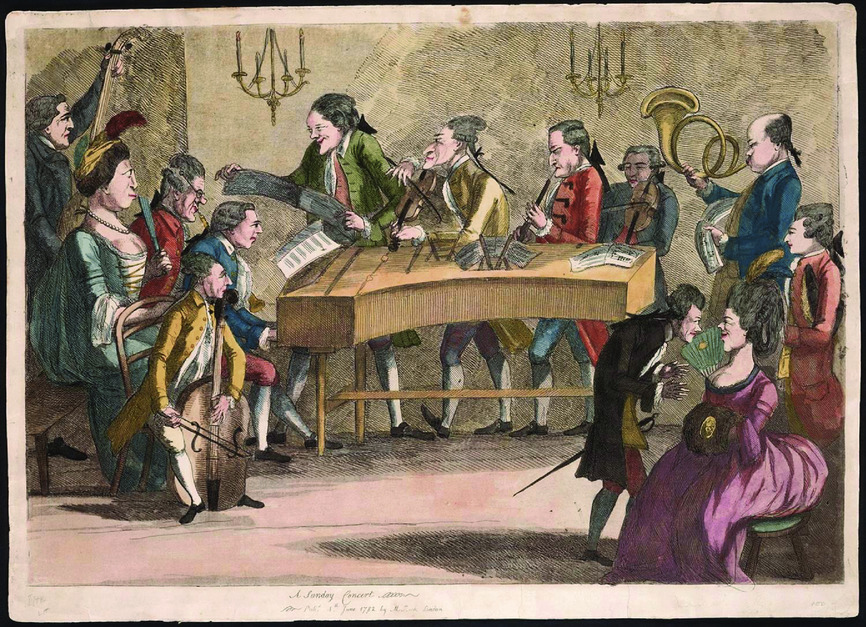
POSSIBLE NOTATION ERRORS AND “IMPROVEMENTS”
The urtext score of this concerto raises many problems typical to urtext of which the most significant is: what do we do about the “obvious” note errors? Every player will need to decide whether to trust their own common sense, ears and musical taste, or whether to just do what the score says (see “Freedom or Obedience” and “Fascism in Music“). If we are willing to be brave, not only can we correct the several apparently erroneous notes: we can even add a few new ones (to “improve” the piece), and remove some others (to make it more playable).
POSSIBLE NOTE ADDITIONS
Here are three suggestions for note additions for some of the little cadenza-type interventions in the first movement. The first suggestion is simply more fun and less predictable than the original. The second suggestion is also more fun, but is especially interesting in that avoids a deathly silence (for both orchestra and soloist) in what should be a culminating firework explosion of soloistic sparkling virtuosity. The third suggestion is simply the continuation of one note more (higher) in the harmonic series and also avoids a hollow silence. They have been notated here in double-time for easier reading and tempo choice:
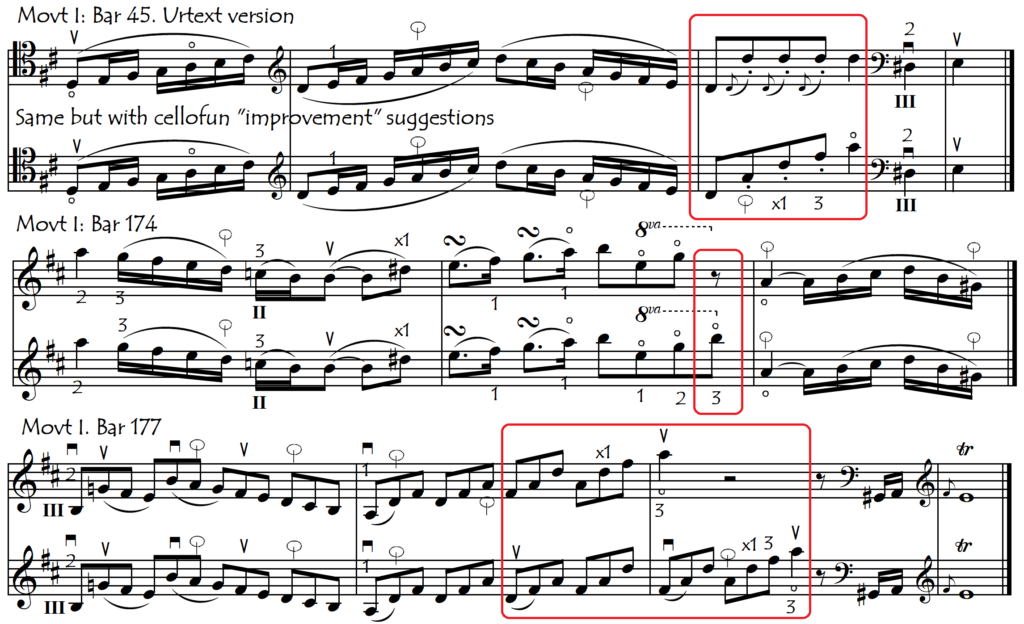
POSSIBLE NOTE CHANGES AND REMOVALS ?
Here below are some more suggestions, now in the final movement and mainly for “note-removals” to make the concert more playable. “Note-removal” sounds quite radical, but in fact we are only suggesting the removal of the lower octave notes in several passages of fast difficult octaves. Removing the lower notes of the most difficult octave passages is a fairly non-invasive (composer-respectful) and audience-friendly way of improving the playability of a piece. The same modification can be used to greatly help us in Tchaikovsky’s Rococo Variations and the Dvorak Concerto as well as in other virtuoso pieces (see Octave Removal Experts). Also, in each appearance of the 16th-note passage, we have converted the D natural always to a D# in order to avoid suddenly having to play a whole tone between the 2nd and 3rd fingers.
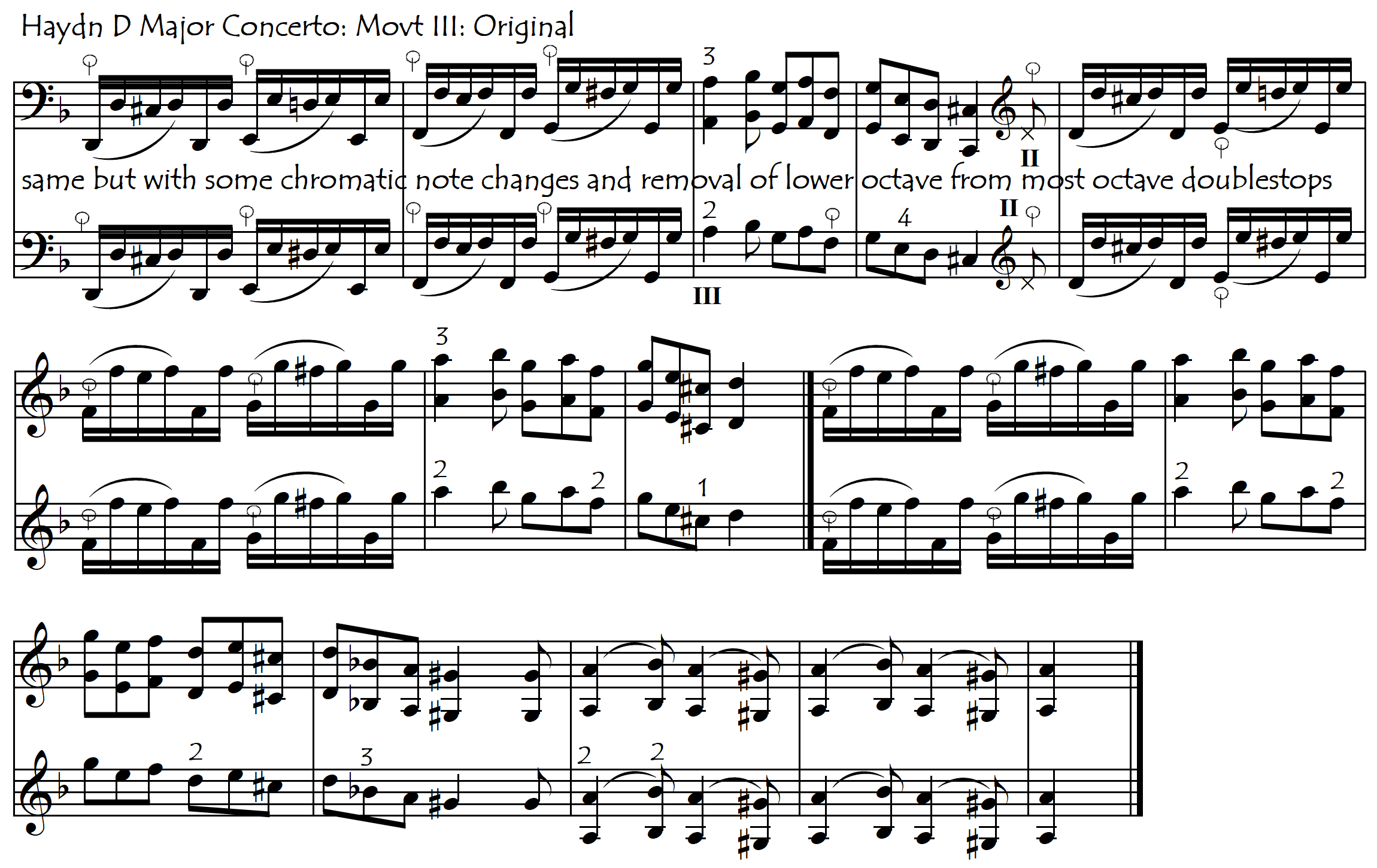
We could also simplify the following passage, using a pedal C-string instead of having to do the fast octave stretches/shifts and changing the (probably erroneous) Bb to a B natural. The rising bass line that has been removed from the cellofun version solo part is not however lost because it is played/doubled by the accompaniment:

STYLISTIC UNITY
As a curiosity, look at the opening themes of each of the three movements of this concerto. The same dotted descending minor third figure appears twice in each theme, giving a certain unity to the entire concerto:

And here is another motif, shared between the first and second movements. The triplet version of this motif found in the second movement, (the last enclosed example above), actually has a certain rhythmic unity with the main theme of the last movement (see above):

We can also give/create stylistic unity with our choices of bowings, for example by using the portato bowing of the first theme also in the second theme (first movement):

HAYDN’S C MAJOR CONCERTO
In Haydn’s C-major concerto, we wouldn’t dream of modifying, adding or removing even one single note. There is just no need: the concerto is perfect as it is, both musically and cellistically. The slow movement of Haydn’s Symphony Nº 13 has many similarities with the slow movement of this concerto.
